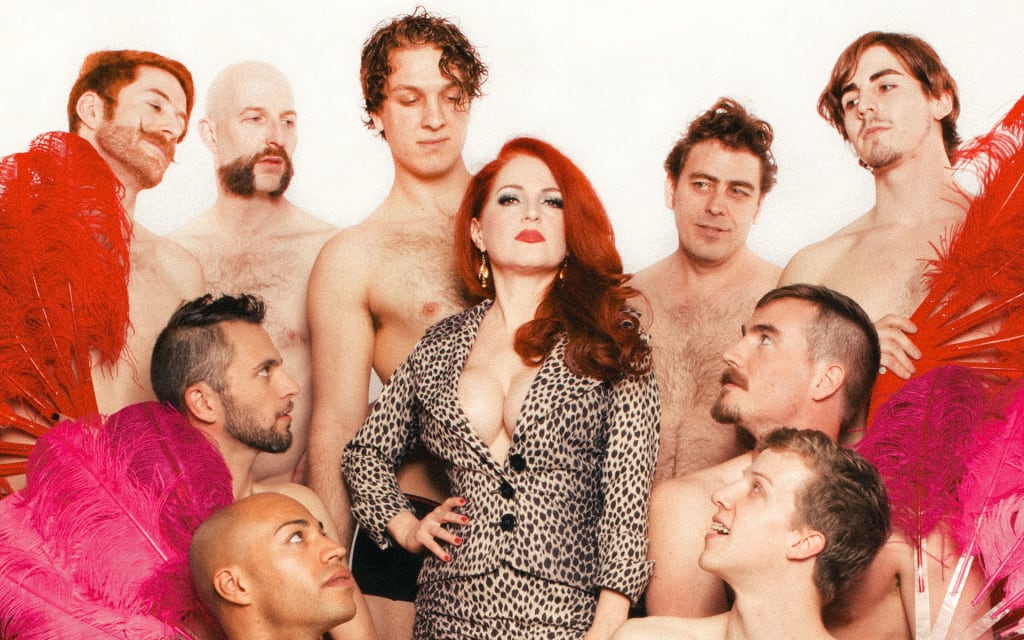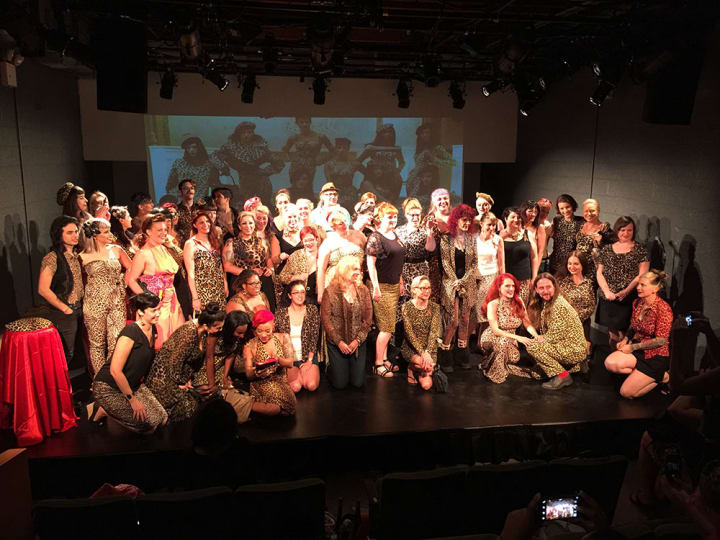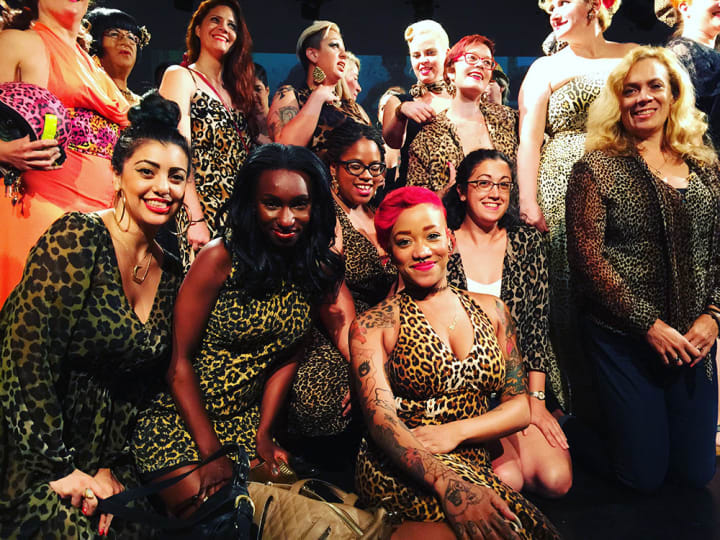Jo Weldon Interview
A revealing talk with burlesque icon Jo Weldon.

Like many women, Jo Weldon is fascinated by fashion; she just takes that fascination to a much higher level. When she’s not teaching women to uncover their inner ecdysiast as headmistress of The New York School of Burlesque, she’s researching, writing, and lecturing about leopard print in her one-woman show, "Fierce: The History of Leopard Print," which takes audiences through the history and legacy of this singularly sexy fashion statement. Filthy Media sent Eric Danville to speak with Jo about how leopard print brings out the animal in us all.
Filthy: When did leopard print first catch your eye?
Jo Weldon: There was a defining moment with Eartha Kitt, who played Catwoman on the TV show Batman. She didn’t wear leopard print, but she was surrounded by leopard print. She had henchmen in animal print. I had a photo of her in a leopard print coat and dress with a cheetah on a leash. I thought "Catwoman" was Eartha Kitt’s real name! Well, my dad snuck me in to see her perform live in a nightclub when I was a little kid. She was amazing. She was purring and rattling. She was laughing at us, but making us love it. I was a little kid and couldn’t really grasp a lot of it, but it seemed that everybody in the room felt like they were doing something really wild and subversive and daring.
I don’t know how my dad arranged it, but afterward Eartha came by our table. She said, "Hello, little girl, your father told me you wanted to meet me!" She threw her head back and laughed, and she walked off. I just lost my shit, because Catwoman was real! There was a real shifting of reality in my head.
A few years later I became socially conscious, sort of politicized by the shootings at Kent State University in 1970, when four unarmed kids were shot and killed by the National Guard. It took me a long time to process some of that. There were a lot of conservative adults around me who were saying that it had to be done. I felt unprotected. I felt more like those kids than the adults around me.
Then I found out that just a couple of years earlier Eartha Kitt had come out against the Vietnam War at the White House and had gotten ostracized because of it. So this woman of style—the woman of the largest closet, who had all those animal-print henchmen—became a woman of substance to me. She became a woman who was strong in all these different ways.





When did leopard skin go from being for survival and protection to being a fashion statement?
Clothing hasn’t always served as a form of self-expression the way it does now. Throughout history, people in a lot of regions had very little clothing, so [using clothing for] self-expression didn’t really come into it. They might have appropriate work clothes or morning clothes, but only royals and well-to-do people had any sense of self-expression with clothing. People didn’t even have closets for their clothing in a lot of apartment buildings and houses prior to the 20th century.
About 200 years ago, people started having access to affordable clothing and larger wardrobes. It didn’t even have a chance to develop as a fashion statement until then, unless you include a brief period before the Napoleonic reign when Napoleon brought back a leopard skin and either hung it on his wall or put it on his floor. That set off this rage for leopard print, but it was considered rather foppish and debauched to wear it at that time, so it didn’t last very long.
Which 20th century designers made leopard the go-to animal print?
It got famous primarily because of Christian Dior in the 1940s. It had been around here and there, but Dior really legitimized it as a fashion statement. He always said, "If you’re fair and sweet, don’t wear it!" He was influenced by a woman named Mitzah Bricard, a former courtesan who was in his atelier and wore leopard all the time. She always wore a leopard scarf around her wrist. Through him, she influenced the way leopard print was worn.
What message is the woman wearing leopard print sending?
She’s signaling that she may not be a predator, but she’s definitely not prey. There’s an exhibition of defiance in it. We live in a culture where our primary visible religion is associated with a human-like God, but in almost every other culture there’s some association with animals and the spirituality of animals, a relation to nature. I think someone even casually wearing a leopard print scarf is acknowledging that some of their spirit is tied to nature.
Is there any connection between leopard and burlesque?
In burlesque, rockabilly, and pin-up culture, leopard print is tied in with traditional eroticism—and there’s a connection to that in Naja Karamuru. She’s an amazing woman. She was a Brazilian full-blooded Indian, and she used leopard print in her work. She was very well known for it.
Why is leopard print primarily a women’s style? It seems like the only animal print men wore was zebra print in 80s hair metal bands!
(Laughs) There’s an attitude in our culture where cats are like women and dogs are like men. In the movie All Dogs Go to Heaven, the women turn into cats and the men turn into dogs. It’s hard to say how leopard print became associated with women, but there’s definitely an outdoorsy, untamed aspect to it. A feeling of escaping culture, moving more to the animal side.
Leopard print has been used to connect to some kind of service capacity, like someone who serves the royals directly or who serves the gods of the royals directly. It symbolizes someone in the service of a patriarchal power, hence a feminized power. There’s also the idea of sexuality. A lot of times, women who show any sign of sexuality are considered to be out of control, therefore wild, therefore more like an animal, therefore more like a leopard.
The zebra print thing I don’t get! (Laughs) I’m interested in prints of predators, like big cats. Prints of prey like zebra or giraffe are beautiful, but they don’t move me. A scientific study on the impact of these prints of predators on the human eye found that they cause the pupils to dilate the same way it dilates when you’re aroused, so there’s actually a primal aspect to it that isn’t cultural at all. But yes, it isn’t that a man wouldn’t wear leopard, but it’s definitely associated more with women.
Are any men known for wearing leopard print?
Oh yeah, in rock and roll. David Bowie, Prince, Rod Stewart, Keith Richards, Little Richard. I could go on and on! Rock stars have a history of being extremely macho, and there’s that kind of reverse thing where "I’m so macho I can dress in women’s prints, I can have long hair, I can wear makeup, and I’m gonna screw your girlfriend!" It’s subversive. Part of the charm of rock and roll is that if you’re not subversive yourself, other people can be subversive on your behalf.
One of my favorite pictures of Poison Ivy Rorscach of The Cramps is her in the leopard print costume.
Poison Ivy is an animal print god! A lot of the ferocious women of punk and early rockabilly share a direct connection to burlesque. A lot of burlesquers in the early stages of burlesque were connected to punk rock and old rockabilly, which was more punk. Animal print had at that point been declared tacky, but they were like, "We don’t care. We’re in your face. We challenge you with our tackiness!" The challenging approach of wearing leopard print in the face of knowing it’s tacky is a big part of the punk-rock movement.
When did it go from being high-fashion to being tacky?
People started wearing leopard fur coats in the early part of the 20th century. That reached its peak of popularity in the early 60s. It became so popular they had to outlaw the hunting of leopards. But up to that point there was the notion that the woman in leopard fur was the trophy wife, and the woman in leopard print was maybe...the mistress! The Vanity Fair leopard print that came up in lingerie, that’s mistressy, whereas the woman wearing the fur is the conqueror, or at least the partner of a conqueror. You can see it turning at the end of the 60s with Anne Bancroft on-screen in The Graduate and in the 70s with Ann-Margret in Tommy. You see this bad mother, and all these terrible consequences are predicated on the mother’s sexual behavior. Leopard became discredited as a kind of "key party," slutty print, and punk rockers were like, "Oh, that’s for me!"
Jo Weldon is the author of The Burlesque Handbook and writes about burlesque and fashion on her blog, Undomesticated Women. You can catch "Fierce: The History of Leopard Print" at the Morbid Anatomy Museum in Brooklyn, New York, on May 17th, 2016.
Jo Weldon presents the definitive, easy-to-use, and indispensable guide to the art of burlesque. With a foreword by burlesque enthusiast Margaret Cho, The Burlesque Handbook's feisty attitude and helpful advice are sure to entertain and inform fans and performers of burlesque alike.
About the Creator
Eric Danville
Adult magazine editor, pop culture historian and sexual satirist. Author of The Complete Linda Lovelace and The Official Heavy Metal Book of Lists.






Comments
There are no comments for this story
Be the first to respond and start the conversation.